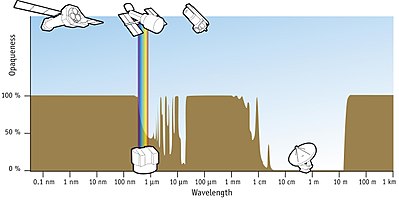 X-rays start at ~0.008 nm and extend across the electromagnetic spectrum to ~8 nm, over which Earth's atmosphere is opaque.
X-rays start at ~0.008 nm and extend across the electromagnetic spectrum to ~8 nm, over which Earth's atmosphere is opaque. An X-ray astronomy satellite studies X-ray emissions from celestial objects, as part of a branch of space science known as X-ray astronomy. Satellites are needed because X-radiation is absorbed by the Earth's atmosphere, so instruments to detect X-rays must be taken to high altitude by balloons, sounding rockets, and satellites.
A detector is placed on a satellite which is then put into orbit well above the Earth's atmosphere. Unlike balloons, instruments on satellites are able to observe the full range of the X-ray spectrum. Unlike sounding rockets, they can collect data for as long as the instruments continue to operate. For example, the Chandra X-ray Observatory has been operational for more than twenty one years.
Active X-ray observatory satellites
Satellites in use today include the XMM-Newton observatory (low to mid energy X-rays 0.1-15 keV) and the INTEGRAL satellite (high energy X-rays 15-60 keV). Both were launched by the European Space Agency. NASA has launched the Swift observatory, Chandra observatory and IXPE telescope. One of the instruments on Swift is the Swift X-Ray Telescope (XRT). JAXA has launched the XRISM telescope.
 This SXI image of the Sun was a first test of the imager taken on August 13, 2009, at 14:04:58 UTC.
This SXI image of the Sun was a first test of the imager taken on August 13, 2009, at 14:04:58 UTC. The GOES 14 spacecraft carries on board a Solar X-ray Imager to monitor the Sun's X-rays for the early detection of solar flares, coronal mass ejections, and other phenomena that impact the geospace environment.[1] It was launched into orbit on June 27, 2009, at 22:51 GMT from Space Launch Complex 37B at the Cape Canaveral Air Force Station.
On January 30, 2009, the Russian Federal Space Agency successfully launched the Koronas-Foton which carries several experiments to detect X-rays, including the TESIS telescope/spectrometer FIAN with SphinX soft X-ray spectrophotometer.
ISRO launched the multi-wavelength space observatory Astrosat in 2015. One of the unique features of ASTROSAT mission is that it enables the simultaneous multi-wavelength observations of various astronomical objects with a single satellite. ASTROSAT observes universe in the optical, Ultraviolet, low and high energy X-ray regions of the electromagnetic spectrum, whereas most other scientific satellites are capable of observing a narrow range of wavelength band.
The Italian Space Agency (ASI) gamma-ray observatory satellite Astro-rivelatore Gamma ad Imagini Leggero (AGILE) has on board the Super-AGILE 15-45 keV hard X-ray detector. It was launched on April 23, 2007, by the Indian PSLV-C8.[2]
The Hard X-ray Modulation Telescope (HXMT) is a Chinese X-ray space observatory, launched on June 15, 2017 to observe black holes, neutron stars, active galactic nuclei and other phenomena based on their X-ray and gamma-ray emissions.[3]
The 'Lobster-Eye X-ray Satellite' was launched on 25 July 2020 by CNSA. it is the first in-orbit telescope to utilize the Lobster-Eye imaging technology of ultra-large field of view imaging to search for dark matter signals in the x-ray energy range.[4]
A soft X-ray solar imaging telescope is on board the GOES-13 weather satellite launched using a Delta IV from Cape Canaveral LC37B on May 24, 2006.[5] However, there have been no GOES 13 SXI images since December 2006.
Although the Suzaku X-ray spectrometer (the first micro-calorimeter in space) failed on August 8, 2005, after launch on July 10, 2005, the X-ray Imaging Spectrometer (XIS) and Hard X-ray Detector (HXD) are still functioning.
The Russian-German Spektr-RG carries the eROSITA telescope array as well as the ART-XC telescope. It was launched by Roscosmos on 13 July 2019 from Baikonur and began collecting data in October 2019.
The Solar Orbiter (SOLO) will approach to 62 solar radii to view the solar atmosphere with high spatial resolution in visible, XUV, and X-rays. The nominally 6 yr mission will be from an elliptical orbit around the Sun with perihelion as low as 0.28 AU and with increasing inclination (using gravity assists from Venus) up to more than 30° with respect to the solar equator. The Orbiter will deliver images and data from the polar regions and the side of the Sun not visible from Earth.[6] It launched in February 2020.
Past X-ray observatory satellites
Past observatories include SMART-1, which contained an X-ray telescope for mapping lunar X-ray fluorescence, ROSAT, the Einstein Observatory (the first fully imaging X-ray telescope), the ASCA observatory, EXOSAT, and BeppoSAX. Uhuru was the first satellite launched specifically for the purpose of X-ray astronomy. Copernicus which carried an X-ray detector built by University College London's Mullard Space Science Laboratory made extensive X-ray observations. ANS could measure X-ray photons in the energy range 2 to 30 keV. Ariel 5 was dedicated to observing the sky in the X-ray band. HEAO-1 scanned the X-ray sky over 0.2 keV - 10 MeV. Hakucho was Japan's first X-ray astronomy satellite. ISRO's IRS-P3 launched in 1996 with the Indian X-ray Astronomy Experiment (IXAE) on board which aimed to study the time variability and spectral characteristics of cosmic X-ray sources and for detection of transient X-ray sources. IXAE instruments consisted of three identical pointed mode proportional counters (PPCs) operated in the energy range 2-20 keV, FOV of 2° x 2° and effective area of 1200 cm2, and an X-ray sky monitor (XSM) operating in the energy range 2-10 keV.You received this message because you are subscribed to the Google Groups "1top-oldtattoo-1" group.
To unsubscribe from this group and stop receiving emails from it, send an email to 1top-oldtattoo-1+unsubscribe@googlegroups.com.
To view this discussion on the web visit https://groups.google.com/d/msgid/1top-oldtattoo-1/CAGNPKm%3DVfdfh%3DbE%2B-PX8ku6Y-3HacBUyTO8XaDQJc8fqAiFU%3Dw%40mail.gmail.com.

No comments:
Post a Comment